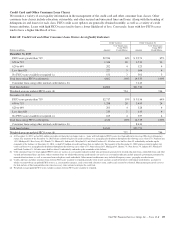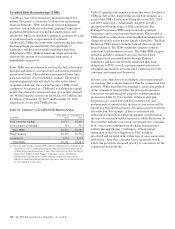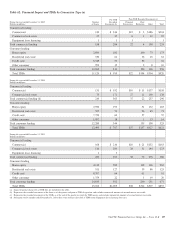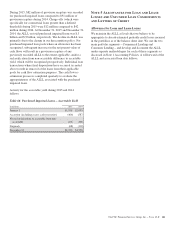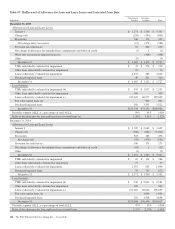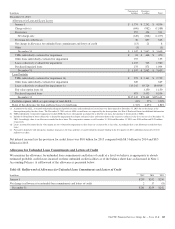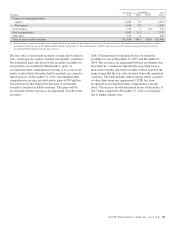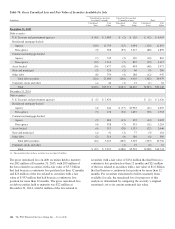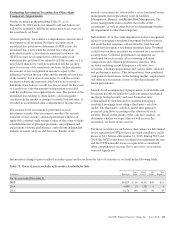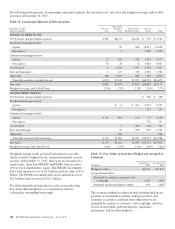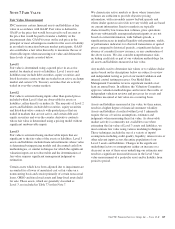PNC Bank 2015 Annual Report Download - page 158
Download and view the complete annual report
Please find page 158 of the 2015 PNC Bank annual report below. You can navigate through the pages in the report by either clicking on the pages listed below, or by using the keyword search tool below to find specific information within the annual report.
N
OTE
4P
URCHASED
L
OANS
Purchased Impaired Loans
Purchased impaired loan accounting addresses differences
between contractual cash flows and cash flows expected to be
collected from the initial investment in loans if those
differences are attributable, at least in part, to credit quality.
Several factors were considered when evaluating whether a
loan was considered a purchased impaired loan, including the
delinquency status of the loan, updated borrower credit status,
geographic information, and updated LTV. GAAP allows
purchasers to account for loans individually or to aggregate
purchased impaired loans acquired in the same fiscal quarter
into one or more pools, provided that the loans have common
risk characteristics. A pool is then accounted for as a single
asset with a single composite interest rate and an aggregate
expectation of cash flows. Purchased impaired homogeneous
consumer, residential real estate and smaller balance
commercial loans with common risk characteristics are
aggregated into pools where appropriate, whereas commercial
loans with a total commitment greater than a defined threshold
are accounted for individually. For pooled loans, proceeds of
individual loans are not applied individually to each loan
within a pool, but to the pool’s recorded investment since it is
accounted for as a single asset.
Prior to December 31, 2015, upon final disposition of a loan
within a pool and for loans that had nominal collateral value/
expected cash flows, the loan’s carrying value was removed
from the pool and any gain or loss associated with the
transaction was retained in the pool’s recorded investment.
Effective December 31, 2015, in anticipation of the end of the
life of our purchased impaired pooled consumer and
residential real estate loans, and pursuant to supervisory
direction, we changed our derecognition policy for these loans
such that we will write-off the loan’s recorded investment and
derecognize the associated ALLL upon final disposition.
Gains and losses on such loans will be recognized as either an
adjustment to the pool’s associated ALLL, or yield, as
appropriate. The transition to this new policy on December 31,
2015 resulted in a $468 million derecognition of recorded
investment and associated ALLL on such loans. See the
discussion below and Note 1 Accounting Policies and Note 5
Allowances for Loan and Lease Losses and Unfunded Loan
Commitments and Letters of Credit for additional information.
The following table provides balances of purchased impaired loans at December 31, 2015 and December 31, 2014:
Table 65: Purchased Impaired Loans – Balances
December 31, 2015 December 31, 2014
In millions
Outstanding
Balance (a)
Recorded
Investment
Carrying
Value
Outstanding
Balance (a)
Recorded
Investment
Carrying
Value
Commercial lending
Commercial $ 94 $ 36 $ 24 $ 159 $ 74 $ 57
Commercial real estate 155 133 96 307 236 174
Total commercial lending 249 169 120 466 310 231
Consumer lending
Consumer 1,769 1,407 1,392 2,145 1,989 1,661
Residential real estate 1,915 1,946 1,700 2,396 2,559 2,094
Total consumer lending 3,684 3,353 3,092 4,541 4,548 3,755
Total $3,933 $3,522 $3,212 $5,007 $4,858 $3,986
(a) Outstanding balance represents the balance on the loan servicing system. Recorded investment may be greater than the outstanding balance due to expected recoveries of collateral.
The excess of undiscounted cash flows expected at acquisition over the estimated fair value is referred to as the accretable yield
and is recognized as interest income over the remaining life of the loan using the constant effective yield method. The difference
between contractually required payments at acquisition and the cash flows expected to be collected at acquisition is referred to as
the non-accretable difference and is not recognized in income. Subsequent changes in the expected cash flows of individual or
pooled purchased impaired loans will either impact the accretable yield or result in an impairment charge to provision for credit
losses in the period in which the changes become probable. Decreases to the net present value of expected cash flows will generally
result in an impairment charge recorded as a provision for credit losses, resulting in an increase to the ALLL, and a reclassification
from accretable yield to non-accretable difference.
140 The PNC Financial Services Group, Inc. – Form 10-K







